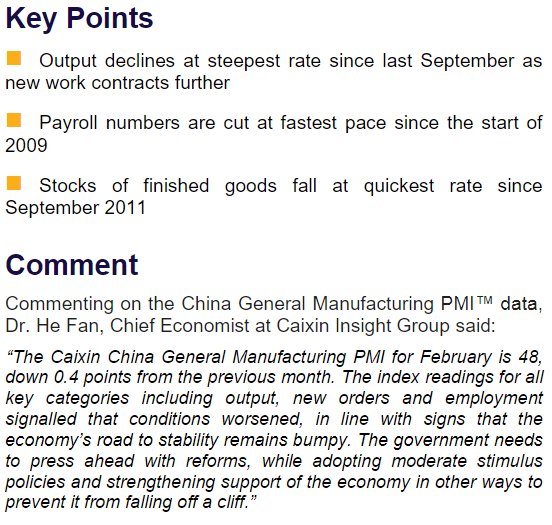Let us begin with China where the PBoC cut the reserve requirement (RRR) for banks as it tries to stabilize growth.

Source: TradingEconomics

More easing in the near-term is likely as economic reports from China remain poor.
1. The official manufacturing and non-manufacturing PMI measures (released this morning for February) are trending lower.


Source: TradingEconomics
2. Similarly, the China Caixin PMI (private report) was also terrible (note that PMI < 50 means contraction).


Source: Markit/Caixin
One item of note in this latest report is more job cuts. Beijing is not going to tolerate this and further stimulus spending to cushion the slowdown is likely.
Continuing with Emerging markets, …
1. Modi’s government sticks to its fiscal deficit targets, sending Indian bond yields lower and the rupee higher.

2. Colombia’s unemployment rate jumps as weak commodity prices take their toll.

3. Nigeria’s foreign exchange reserves are the lowest in over a decade. Capital outflows have been costly.

Now on to Japan where we focus on a number of trends.
1. Japan’s labor shortages worsen as jobs per applicant continue to rise.

2. There is evidence that the Japanese have shifted some funds abroad to escape negative rates. So far it’s not enough to weaken the yen.

3. Japanese firms are hoarding cash.

Source: @onlyanna100, h/t Josh
4. Here is what happened with Japan’s interbank lending since the introduction of negative rates.

Source: @martin_whetton, h/t Josh
Australian manufacturing activity surprised to the upside and is now the strongest it has been since 2010. The weakness in the Australian dollar is helping,

Source: ?TradingEconomics
Switching to the Eurozone, the area’s CPI missed economists’ forecasts. Draghi has to be readying a “bazooka” stimulus increase.













Leave A Comment